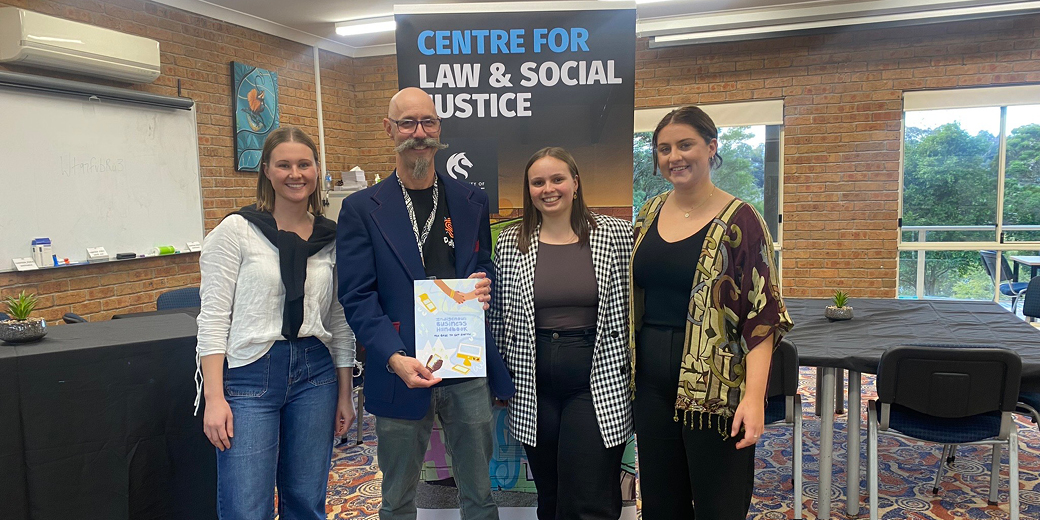Obtaining clear instructions from your client may seem like a straightforward requirement as a lawyer. After all, a lawyer’s role is to understand a client’s situation, provide advice informed by their knowledge of the law, and present a range of options from which clients may choose to act. However, this can be easier said than done if a client is in a fraught emotional state (and if they are seeing a lawyer this may be the case) or if there are differences in culture. Both scenarios can lead to inadvertent misunderstandings.
Special Counsel Olamide Kowalik knows this all too well. As part of the Springwood-based Revolution Law team, Olamide advises clients from a wide range of backgrounds. We caught up with Olamide, who is a finalist for Regional Suburban Lawyer of the Year, finalist in the Women Lawyers’ Association of Queensland Una Prentice Award and co-host of Tile and Olly Meets podcast, to explore how she navigates these issues, and how a lawyer’s duty to obtain clear instructions can look in practice.
Avoiding unnecessary legalese, showing patience and not jumping to conclusions about your client - are all part of improving client outcomes.
What is the ‘duty to obtain clear instructions’?
”The courts and the profession have long agreed that a significant distinction can be drawn between sophisticated and unsophisticated clients; solicitors will be expected to go to greater efforts to ensure that unsophisticated clients understand the situation and their options,” Olamide explains, quoting a Queensland Law Society resource, ‘Success Starts with Consensus and Clear Instructions.’
To discharge our duty as lawyers, Olamide argues it is imperative that greater care is taken to obtain clear instructions from a client at the outset.
“This can greatly affect the quality of the advice you provide,” Olamide says. “Using legalese can often serve to throw greater distance between you and the client. Be honest - is the legalese serving your client, or your ego? Because using legalese draws you no closer to really understanding your client.”
Why is it so important to ‘know your client’? To understand context, culture, and values?
“If you do not know your client’s case, you cannot competently discharge your duty to act for your client,” Olamide observes. “Poor communication leads to poor representation which further disadvantages the client.”
With seven million Australians born overseas - or 27.6% of the total Australian population according to 2021 Australian Bureau of Statistics (ABS) figures - the potential for miscommunication is significant. These ABS figures also note a shift in where our newest migrants are coming from, with more new Australians coming from China, India, Vietnam, Nepal and the Philippines, alongside traditional migration from New Zealand and England. Of these, 5.8 million people report using a language other than English at home, up from 4.9 million in 2016.
Outlined in the ABS data, 3.4% of these Australians don’t speak English well or at all. Interpreters can help bridge this gap and many migrant children are familiar with playing the role of informal interpreter between their non-English speaking parents and the wider world. This includes dealing with electricity companies, internet providers and, in some cases, lawyers. But culture goes deeper than differences in language.
“The client may not be able to speak or understand any English at all,” Olamide says. “They may also be illiterate and unsophisticated.”
“Navigating and communicating their rights can be challenging as they have no point of reference for effective comparison.”
According to Olamide, lawyers must be able to explain the legal process to the claimant in a way they can understand.
“The rule of law might be very different from where they have come from, and it may not effectively protect their rights. After all, you may be dealing with clients fleeing a war zone, dictatorship, or a general breakdown in law and order.”
It is therefore important for lawyers to ‘read the room’.
“For instance, from a cultural perspective, the client might prefer a female lawyer. Conversely, culture may mean a female client cannot be alone with a male lawyer,” Olamide explains. “Sometimes a client can’t shake your hand, and this isn’t meant to be rude - it’s just a difference in cultural nuance, practice and expectation. It is important for lawyers to adapt to the situation in front of them. As a lawyer your goal is to be able to understand your client and, to do so, you need to put them at their ease.”
The dangers of failing to read the room can also be significant.
“If it is clear there have been communication failures throughout the life of a claim, arising from cultural and language barriers, this might leave a lawyer open to allegations of substandard representation - which, in the worst case scenario, might amount to negligence,” Olamide says.
How can you ensure your client understands your instructions?
Unconscious bias and judgement can come into play when a client does not speak English. This may fall to social conditioning and does not accurately represent the intellect of your client. A failure to understand causes frustration in whoever is trying to convey information, and an unexamined response would be to assume that this is the fault of the client receiving information.
“Just because a client doesn’t speak English does not mean they’re not intelligent,” Olamide states.
- Find an interpreter fluent in your client’s dialect - and be patient
Addressing differences in language means more than just finding an interpreter. Much like a thick Scottish accent can feel quite foreign to other English speakers, most languages have differences in dialect, words and meaning.
“It’s important to engage an appropriate interpreter,” Olamide says. “This means an interpreter well-versed in the client’s particular dialect. And where possible and available, request accredited interpreters.
“Equally important is understanding that languages do not always translate smoothly from English to another language, like the native language of your client. The word or meaning for what you’re trying to convey simply might not exist.”
- Don’t speak too fast - it’s a second language
With this in mind, Olamide has found it can help to slow down your pace, and as much as possible, keep the message simple.
“Don’t speak too fast,” Olamide advises. “Just listen to your own voice. After all, a client may be proficient in English - but it’s still a second language to them. Just as you might struggle to understand French, Spanish or Mandarin, especially when a fluent speaker is speaking fast, or using complex words, your client might struggle too."
"Avoid speaking too fast or using really long words when you can.”
This can of course be a challenge in the law, as much of the law is dense with legalese and the information by its nature is complex. Conveying it clearly and simply is a skill in itself.
- Sense-check your client’s understanding by asking them to relay your advice.
“I would recommend having the client relay their understanding of the advice,” Olamide says. “This might help identify areas the client is not clear on, which allows the lawyer the opportunity to go over it again.
“Confirm your understanding of the client instructions in writing. This allows the client to talk to someone they are comfortable with to interpret, and take the time to do so.”
Naturally, a level of patience will be required to ensure your client fully understands your advice. This is an approach which reflects best practice.
“It is important to make time at the start, over and above what it would ordinarily take to obtain very detailed instructions, to clearly understand what has happened and how it has happened, to go through the claims process and to set expectations from the outset, as well as allow time for questions.”
- Speak plain English, not legalese
The Guideline Working with Interpreters in Queensland Courts and Tribunals noted:
Legal practitioners should use their best endeavours to use plain English to communicate clearly and coherently during court proceedings. Legal practitioners should speak at a speed and with appropriate pauses so as to facilitate the discharge by the interpreter of their duty to interpret.
Meeting these guidelines will take time and patience.
“You may have to allow double the time that it would normally take, but it’s worth it to ensure you meet these guidelines and most importantly, meet the needs of your client. This is what it means to be a good lawyer and meet your duty of care,” Olamide says.
It’s also useful to understand where the client may be coming from, Olamide suggests researching their culture, or asking someone familiar with their culture.
“Be aware also of your own potential unconscious bias,” Olamide says. “Even the most well-meaning lawyers might find they have relied on their own assumptions about what a client means. It’s always a good idea to ask a client to elaborate on what they mean. This way, you can ensure you are providing legal advice that actually assists with the problem they have.”
- Put the client at ease
To properly advocate for a client, a lawyer must be able to understand what has happened Olamide says.
“Clients are typically nervous when engaging with a lawyer as it means something has ‘gone wrong’ or something is at stake.”
With this in mind, it’s important to help put your client at their ease.
“A client will not be at ease if they do not understand their lawyer or feel they have to ‘sound smart'. For a client to trust you, you must be open to asking many questions and reassure them that you are there to help them and paint them in the best light,” Olamide explains.
“Only when you have the story in its most accurate form can you be assured that the advice you provide is sound and valuable.”
So how do you know when your client understands your legal advice? Olamide's firm serves a predominantly migrant community and so she has a great deal of experience in this area.
“I can see when a client relaxes in my presence and that their demeanour changes,” Olamide says. “They might even laugh or share more of their story, which can help you better understand the situation. They’ll speak more freely, even through an interpreter.”
- Ensure that it’s your client who makes the final decision
It is important to ensure the client both understands your advice and makes decisions for themselves.
“I have had clients try to defer the decision making to me,” Olamide shares. “This might be because they are scared of people they perceive to be in positions of authority, because where they come from those in power wield the most influence. If this occurs, I take the opportunity to explain that here in Australia it is the lawyer’s duty to provide advice. But it’s the client who must decide on what they want to do.”
Being a good advocate for your client can sometimes involve pointing out assumptions made by opposing counsel.
“Sometimes, you will need to call out the unconscious bias present in the other side’s case,” Olamide says.
“Sometimes the other side might advance a narrative based on assumptions about a particular group - in other words, cultural or racial assumptions widely held but not specifically true about a particular group. This is when you need to understand your case and know your client better than opposing counsel. In these situations because I have taken the time to understand my client, convey my advice, and clearly receive their instructions, I know the case inside out. This way I can be confident in tackling unconscious bias head on.”
As an African Australian, Olamide is proud to practise law to serve a diverse community.
“I am proud that my clients reflect the multicultural cross-section of our community, from truck drivers to white collar workers, labourers and miners to refugees and stay-at-home parents.”
For more on diversity in the law, check out Olamide’s legal podcast Tile and Olly Meets.

























![How to handle Direct Speech after Gan v Xie [2023] NSWCA 163](https://images4.cmp.optimizely.com/assets/Lawyer+Up+direct+speech+in+drafting+NSW+legislation+OCT232.jpg/Zz1hNDU4YzQyMjQzNzkxMWVmYjFlNGY2ODk3ZWMxNzE0Mw==)





























































